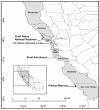Risk factors for infection with pathogenic and antimicrobial-resistant fecal bacteria in northern elephant seals in California
- PMID: 19006978
- PMCID: PMC2289989
- DOI: 10.1177/003335490812300316
Risk factors for infection with pathogenic and antimicrobial-resistant fecal bacteria in northern elephant seals in California
Abstract
Objectives: The goal of this study was to identify potential environmental and demographic factors associated with Campylobacter jejuni (C. jejuni), Salmonella enterica (Salmonella spp.), and antimicrobial-resistant Escherichia coli (E. coli) infection in northern elephant seals stranded along the California coastline.
Methods: E. coli, Salmonella spp., and C. jejuni were isolated from rectal swabs from 196 juvenile northern elephant seals, which were found stranded and alive along the California coast and brought to The Marine Mammal Center in Sausalito, California, for rehabilitation. Gender, weight, county where the animal stranded, month stranded, coastal human population density, exposure to sewage outfall or freshwater outflow (river or stream), and cumulative precipitation in the previous 24 hours, seven days, 30 days, 90 days, and 180 days were analyzed as potential risk factors for infection.
Results: The odds of C. jejuni and antimicrobial-resistant E. coli were higher in feces of seals stranded at sites with higher levels of freshwater outflow compared with lower levels of freshwater outflow. The odds of Salmonella spp. in feces were 5.4 times greater in seals stranded in locations with lower levels of 30-day cumulative precipitation, along with substantially lower odds of Salmonella shedding for seals stranded in Monterey or Santa Cruz county compared with seals stranded in regions further north or south of this central California location.
Conclusions: Juvenile northern elephant seals that have entered the water are being colonized by antimicrobial-resistant and pathogenic fecal bacteria that may be acquired from terrestrial sources transmitted via river and surface waters.
Figures


References
-
- U.S. Census Bureau. United States Census. 2000. [cited 2007 May 25]. Available from: URL: http://www.census.gov/main/www/cen2000.html.
-
- Boehm AB, Grant SB, Kim JH, Mowbray SL, McGee CD, Clark CD, et al. Decadal and shorter period variability of surf zone water quality at Huntington Beach, California. Environ Sci Technol. 2002;36:3885–92. - PubMed
-
- Environmental Protection Agency (US) EPA's BEACH watch program: 2002 swimming season. 2003. [cited 2007 May 25]. Available from: URL: http://www.epa.gov/waterscience/beaches/seasons/beachwatch2003-newformat....
-
- Environmental Protection Agency (US) Risk-based beach evaluation and classification process. 2002. [cited 2007 May 25]. Available from: URL: http://www.epa.gov/waterscience/beaches/grants/guidance/Accessible_pdf/c....
-
- Schiff KC, Morton J, Weisberg SB. Retrospective evaluation of shoreline water quality along Santa Monica Bay beaches. Mar Environ Res. 2003;56:245–53. - PubMed
Publication types
MeSH terms
Substances
LinkOut - more resources
Full Text Sources
Medical
Miscellaneous

